Cut to the chase
6 Effective Methods for Cleaning Bath Toys
- Using a bleach solution
- Vinegar soak
- Dishwasher cleaning
- Boiling and steaming
- Cleaning using a washing machine
- Disinfectant wipes and sprays
Bath time can be a fun and engaging experience for your little ones, but the importance of keeping those bath toys clean cannot be overstated. I am going to show you how to clean bath toys and stop your baby’s bath toys from getting moldy.
I’ve put together my best tips on how to clean bath toys, why you need to keep your baby’s bath toys clean, effective methods for keeping them clean, and tips for selecting easy-to-clean toys.
Let’s ensure that bath time remains a safe and enjoyable activity for your child.
Let’s look at my 6 effective ways for how to clean bath toys
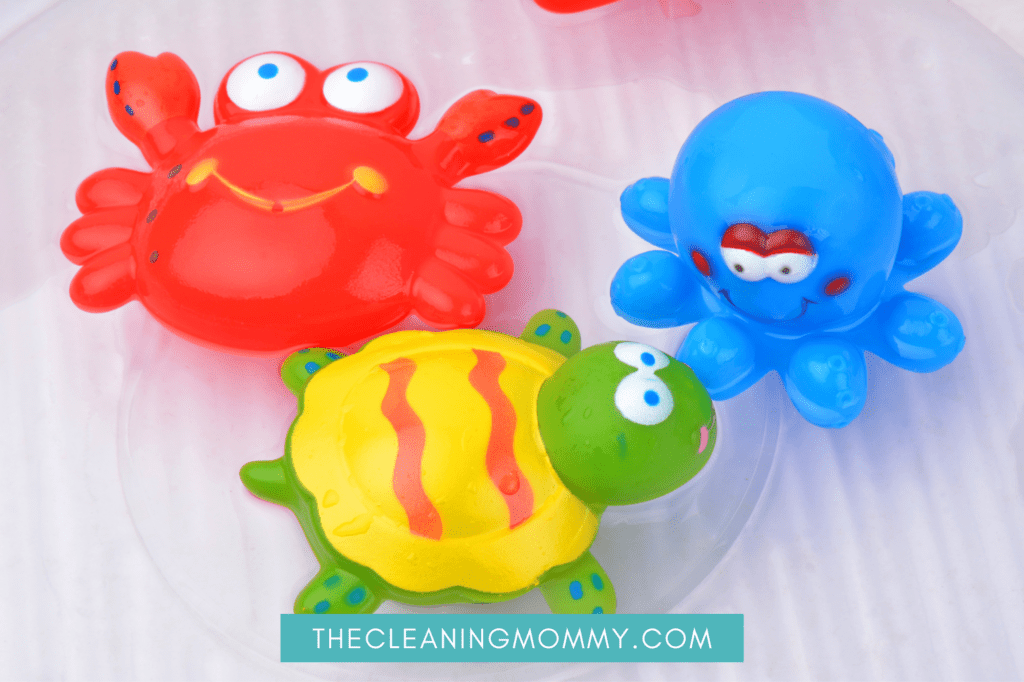
By incorporating one or more of these techniques into your cleaning routine, you can ensure that your child’s clean baby bath toys remain safe and enjoyable to play with, as you learn how to clean bath toys safely.
Keep in mind, no single method is universally perfect, choosing a method suitable to the toy’s material, design, and the manufacturer’s recommendations is paramount.
Let’s explore each method to find out which one is best suited for your child’s bath toys.
#1 How to clean your kids bath toys using a bleach solution
While a bleach solution is an effective way to clean bath toys, caution is needed during its use. Here’s how to clean bath toys with a diluted bleach solution:
I highly recommend that you do this in your bathroom because of the smell that bleach gives off. Turn on your bathroom exhaust fan while you’re cleaning with bleach!
- Mix one teaspoon of household bleach with a gallon of water in a bowl.
- Let the toys soak in the bowl for 30 minutes.
- For toys that squirt water, squeeze toys to suck up the bleach solution to kill anything trapped inside.
- Rinse the toys in soapy water, and then again, in clear water.
Although a bleach solution can be a powerful cleaning agent, it has its drawbacks. Bleach can be irritating to the eyes and nose, may alter the colors and patterns of the toys, and is toxic if ingested. Proper rinsing and drying after cleaning bath toys with a bleach solution is required to minimize these risks.
So make sure to rinse their favorite rubber duck umpteen times (just because it’s bleach) before giving it back!
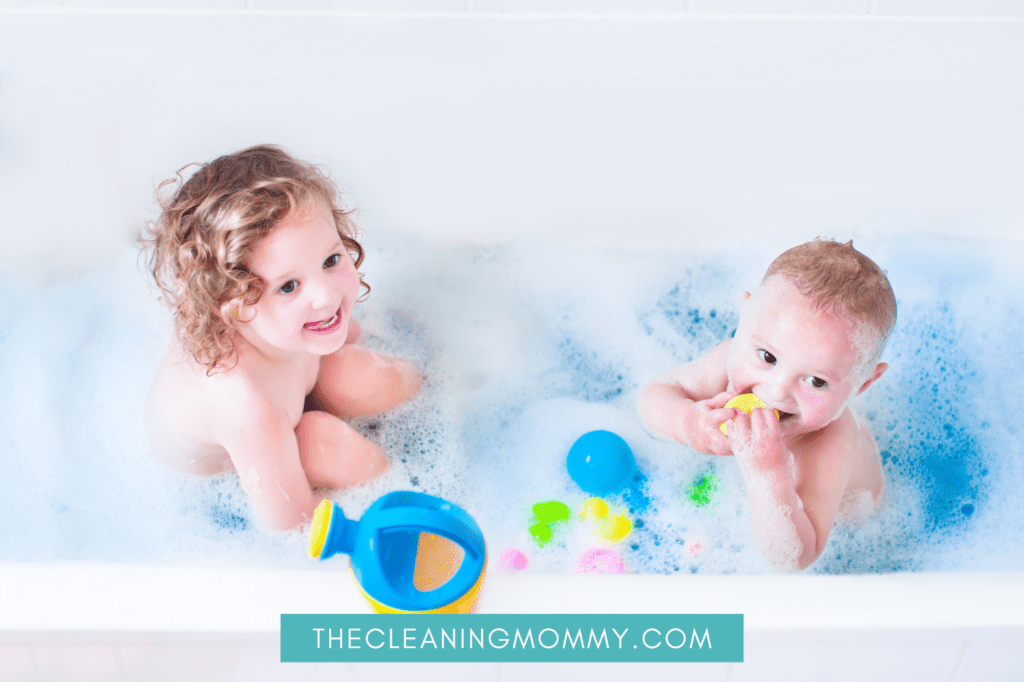
#2 Cleaning your kids bath toys with vinegar
If you’re not new here, then you know I love to clean with vinegar. It has great cleaning powers and you can also use it to clean your children’s bath toys.
Vinegar also has disinfecting powers and it helps prevent future mold and mildew growth. It’s a natural and effective way to clean bath toys.
For those looking for a natural alternative to bleach, a vinegar soak is an excellent option. Here’s how to do it:
- Mix two cups of vinegar with five liters of water.
- Let the bath toys soak in the mixture for at least 30 minutes, make sure they are fully submerged.
- The acidity of the vinegar helps break down soap scum and kill germs without the use of harsh chemicals.
- Rinse the bath toys really well, and let them air dry on your dish drying rack or a towel, before you put them back in the bath.
While vinegar may require a longer soaking time than bleach, it is a safer option, especially for homes with young children or pets.
#3 Cleaning baby toys in the dishwasher
Dishwasher cleaning is a convenient method for cleaning bath toys, particularly for busy parents. Not everyone has time to hand wash intricate toys. But before placing the toys in the dishwasher, check the manufacturer’s recommendations to ensure they are dishwasher safe.
Even after you do that, I would recommend putting just couple of toys inside the dishwasher to make sure they are dishwasher safe. Pick the least favorite ones in case there is an issue!
To clean and disinfect the toys, follow these steps:
- Place the bath toy on the top rack of the dishwasher.
- Run a hot cycle with your normal detergent.
- Once the cycle is complete, carefully remove the toys from the dishwasher and allow them to air dry.
- The dishwasher will not clean the inside of squirty toys, so make sure to suck up a bleach or vinegar solution to clean the insides, and rinse clean several times.
Though dishwasher cleaning is a convenient method, some bath toys may not be suitable for the dishwasher, and the heat from the dishwasher can potentially damage certain toys. I would test this method with one or two toys to see if it works first. Once you are happy with the outcome, you can wash some more. Always inspect the toys after cleaning to ensure they are in good condition and safe for your child to play with
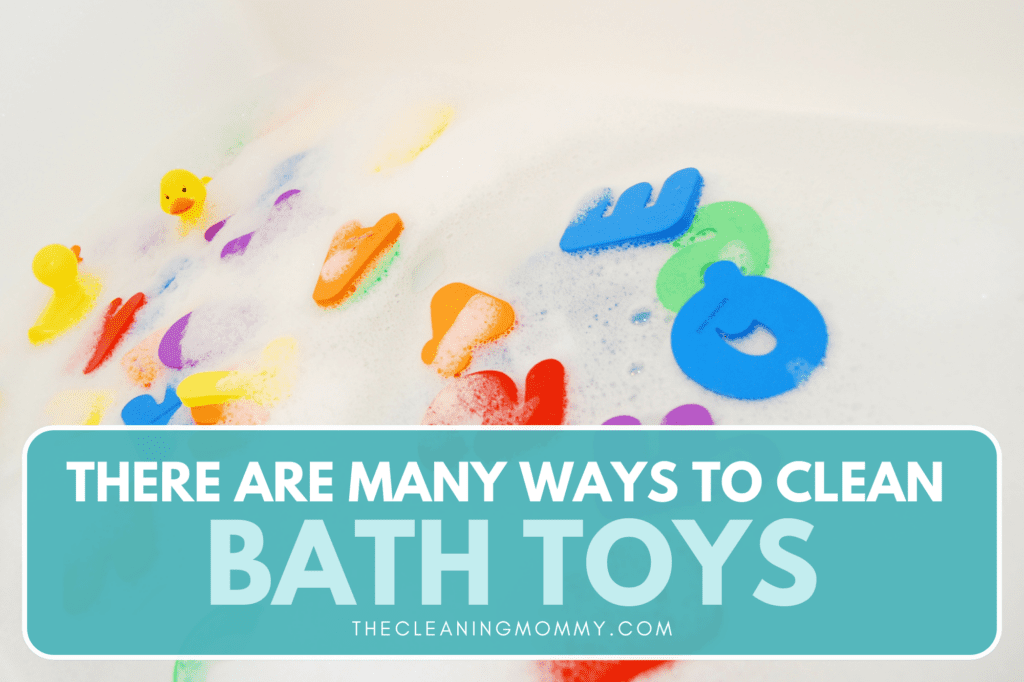
#4 Clean the bath toys by boiling and steaming them
Boiling and steaming are effective methods for sanitizing and cleaning hard plastic toys and foam letters/numbers without the need for harsh chemicals. Fill a large pot of warm water and bring to a boil, add the toys to the boiling water, and let them simmer for a few minutes to disinfect and remove any dirt or germs.
Again, I would test this method on a baby toy first to make sure his favorite duckie doesn’t melt! Mold can easily form inside bath toys, so it’s important to give them a thorough cleaning!
As long as the plastic and rubber toys won’t melt in hot water (check the manufacturer’s recommendations for cleaning), boil your toys by placing a large pot of water on the stove and let them reach boiling point.
Once the water has boiled, place your bath toys into the water using rubber gloves and boil for 3-5 minutes. Boiling toys for too long can cause toys to deform.
After boiling or steaming, remove the bath toys using a kitchen tongs or slotted spoon and let them cool before handling. This method is quick, easy, and effective in killing germs and keeping your child’s bath toys mold free.
#5 Cleaning using a washing machine
Another option for cleaning bath toys is using your washing machine. Place the toys in a mesh laundry bag to prevent any damage during the wash. Put a couple of bath towels in with the toys to reduce the noise! Run a gentle cycle using mild detergent, and make sure to choose a warm water temperature to help kill germs.
Do not put the toys in your dryer! Always air dry the toys thoroughly before allowing your child to use them again.
I would recoomend doing a trial run with one bath toy to ensure this method works. Again, choose their least favorite bath toy in case an accident happens.
#6 Disinfectant wipes and sprays
Disinfectant wipes and sprays, such as Clorox Anywhere Hard Surface Spray or Free & Clear Disinfecting and Sanitizing Mist, can be used for quick and easy cleaning of bath toys. Simply clean the outside of the toy wiht a disinfectant wipe or spray the toys with the disinfectant solution and let them air dry before returning them to your child’s bath tub.
This method is particularly useful to give the baby’s bath toys a clean when you don’t have a lot of time, as it requires minimal effort and is safe to use around children.
However, it may not completely eliminate mold growth in toys with tiny holes, such as squirting toys. This is good for a quick clean, but I highly recommend you try some of the other cleaning methods when you do have time!
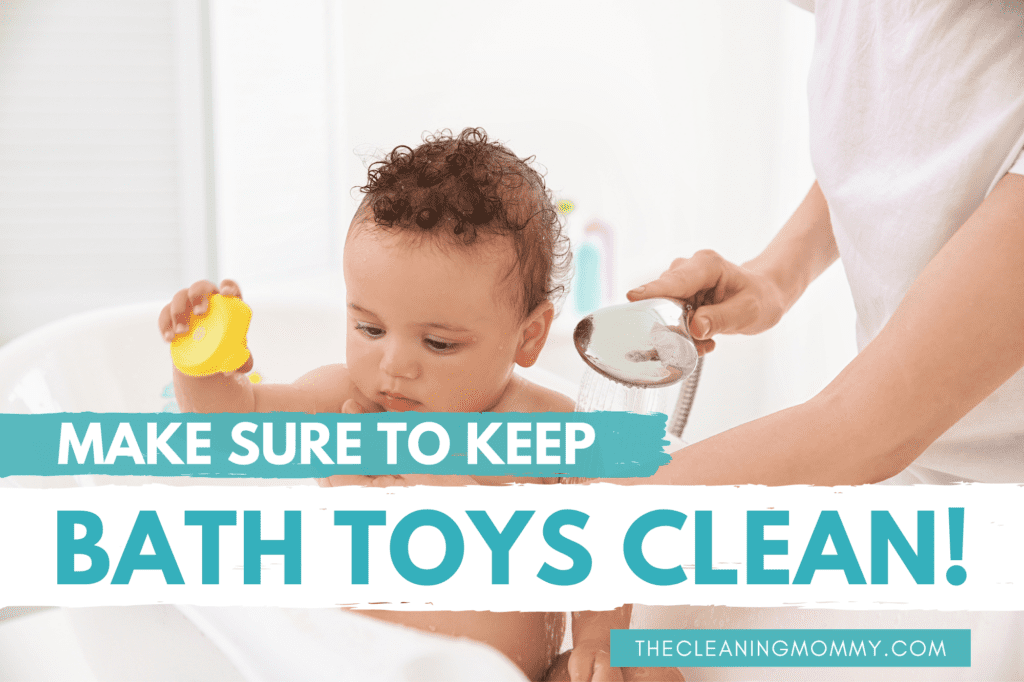
Selecting Easy-to-Clean Bath Toys
Choosing easy-to-clean bath toys can save you time and effort while ensuring a safe and clean play environment for your child. Considerations like material, design features, and mold-resistant options should be made when selecting bath toys.
Who knew you had to put some much thought into selecting your baby’s bath toys!
But, by opting for toys that are easy to clean and less prone to mold growth, you can maintain a fun and healthy bath time experience for your little one.
Let’s take a look at several factors to be considered when selecting easy-to-clean bath toys, this will ensure the best choice for your child’s play time.
Material Considerations
Materials such as hard plastic, silicone, and rubber are suitable options for bath toys that are easy to clean. These materials can be wiped clean and dried after each use, and they also dry out properly between uses, reducing the risk of mold growth.
When selecting child’s bath toys, opt for materials that are not only easy to clean but also safe for your child to play with. Avoid toys made from materials that can harbor mold or bacteria, and ensure the toys are free of toxic chemicals.
Design Features
The design of a bath toy can greatly impact its ease of cleaning. Look for toys with smooth surfaces and minimal crevices, as these can prevent the accumulation of mold and bacteria. Additionally, removable parts that can be taken apart for cleaning can make the process even easier.
By selecting clean kids bath toys with simple designs, you can reduce the time and effort required to clean them, ensuring a safer and more enjoyable bath time experience for your child.
Mold-Resistant Options
Mold-resistant bath toys are designed to prevent water from getting inside, reducing the risk of mold growth. Consider toys made from materials such as stainless steel or natural rubber, or those with an antimicrobial coating to help inhibit the growth of mold and bacteria.
Another option is to make existing bath toys mold-resistant by covering up the holes with a drop of hot glue. By choosing mold-resistant bath toys, you can provide your child with a safer and cleaner play environment during bath time.
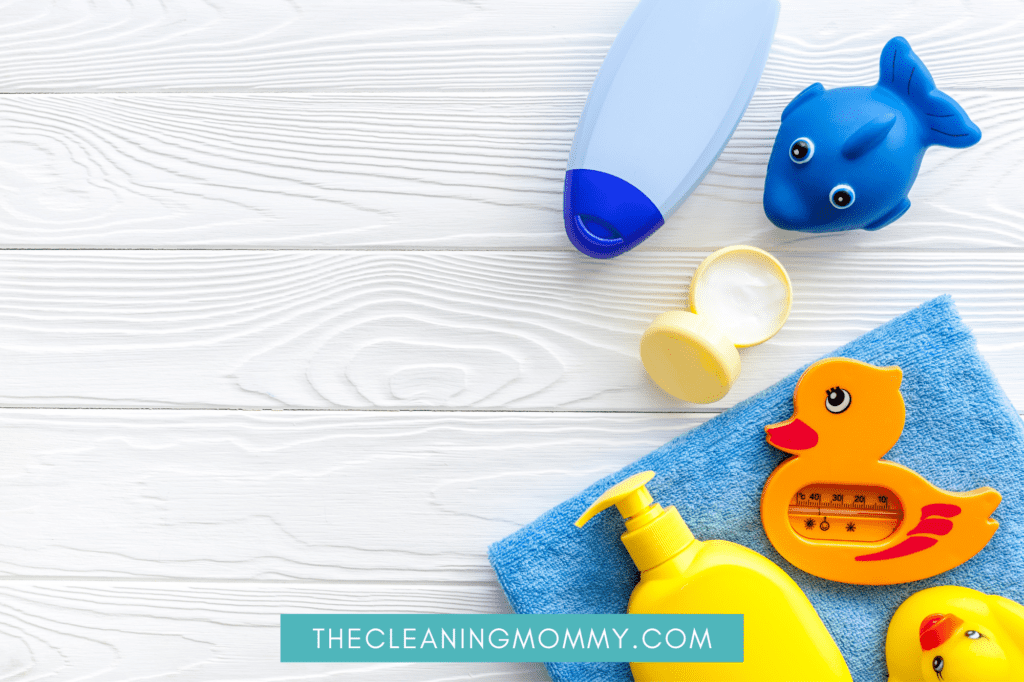
Tips for Preventing Mold and Bacteria Growth
Having explored various cleaning methods and toy selections, we will now understand how to prevent mold and bacteria growth on bath toys. Proper storage, regular cleaning, and toy rotation can significantly reduce the risk of mold and bacteria buildup. By implementing these practices, you can ensure that your child’s bath toys remain safe and clean.
Proper Storage
Storing bath toys in a well-ventilated area or mesh bag can help them dry properly and prevent mold growth. After each use, rinse the toys with tap water to remove soap and residue, and allow them to air dry before storing them. BEcause they are constantly sitting in a humid bathroom, make sure to turn on your bathroom fan and leave it on for minimum 15 minutes after anyone has a bath.
Storing bath toys in a dry and well-ventilated area can significantly mitigate the risk of mold and bacteria growth, thus ensuring a safe and enjoyable bath time experience for your child.
Consider storing your toys using these helpful ideas:
- Mesh Bags. Hang a mesh bag or a toy net on the bathroom wall. This will allow the toys to continue to air-dry and keeps them off the wet surfaces. Remember to wash the bag and net on a regular basis also.
- Plastic Bins: Store bath toys in a plastic bin with ventilation holes. This will help keep the toys organized and promote air circulation to prevent mold growth.
- Shower Caddy, You can use a shower caddy to store your toys, but remember to move them before you have your shower.
Regular Cleaning
As mentioned earlier, regular cleaning of bath toys is essential to maintain their cleanliness and prevent mold and bacteria buildup. Experts recommend sanitizing bath toys on a weekly basis, using one of the cleaning methods discussed earlier in this guide.
Establishing a consistent cleaning routine can curb the growth of mold and bacteria on your child’s bath toys, thus guaranteeing a safer and cleaner bath time experience for your little one.
Toy Rotation
Rotating bath toys can give them time to dry completely between uses, reducing the risk of mold growth. Implement a toy rotation schedule that works best for you and your child, whether it’s every 1-2 weeks or every 6-8 weeks.
Regularly rotating bath toys can help minimize the risk of mold and bacteria growth, thereby ensuring a safe and enjoyable bath time experience for your child.
When to Replace Bath Toys
Look for signs of wear and tear, such as discoloration, bad smell, or visible mold growth. If any of these signs are present, it’s time to replace the bath toys with new ones.
Replacing bath toys as required aids in maintaining a safe and clean bath time experience for your child. Remember, a clean and well-maintained bath toy is not only more enjoyable for your child to play with but also helps protect their health and well-being.
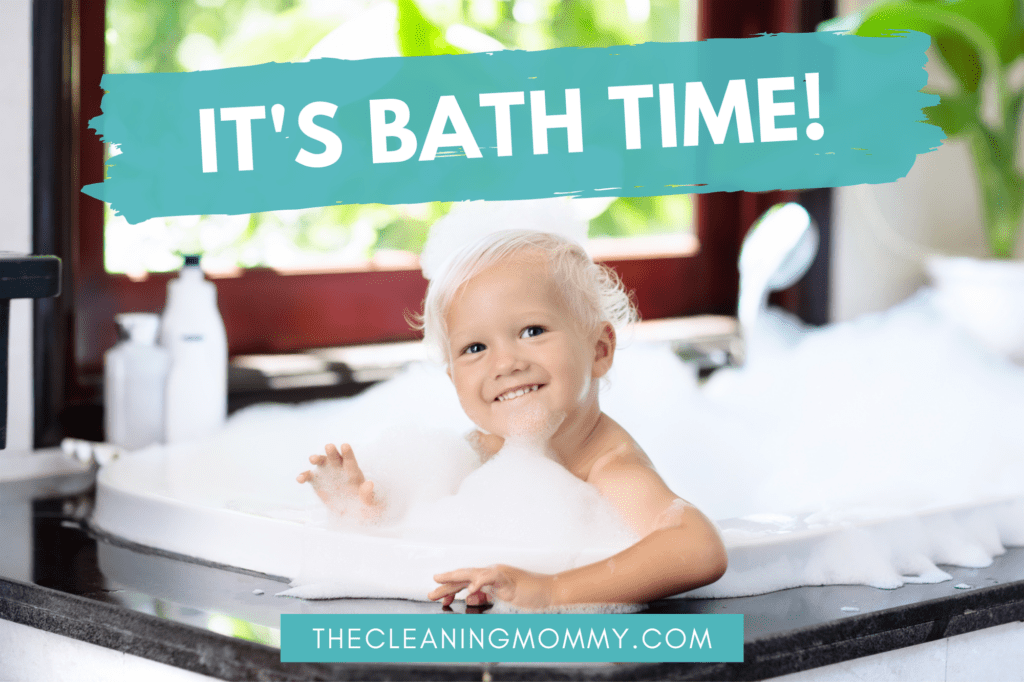
The Importance of Cleaning Bath Toys
Imagine the joy your child experiences during bath time, surrounded by their favorite bath toys. But have you ever wondered about the cleanliness of those toys? Ensuring your child’s bath toys are clean is vital for their health and safety. Unclean bath toys can harbor mold and bacteria, posing health risks, and even reducing the longevity of the toys themselves.
Experts recommend sanitizing bath toys on a weekly basis to prevent mold growth and ensure a safe bath time experience for your child. Maintaining cleanliness of baby bath toys can mitigate the risk of skin irritation, respiratory difficulties, and lung infections.
Let’s delve into the reasons why proper cleaning is of paramount importance.
Mold and Bacteria Growth
Mold and bacteria thrive in moist environments, making bath toys the perfect breeding ground for these unwanted guests. Tiny holes in squirting toys can trap water inside, allowing mold to grow and eventually be released during playtime. Proper storage, regular cleaning, and toy rotation are fundamental steps to prevent mold growth.
The potential health risks associated with mold and bacteria growth on bath toys include skin irritation, respiratory issues, and infections. By taking steps to prevent mold and bacteria growth, you can help protect your child’s health and keep bath time a fun and safe experience.
Health Risks
Unclean bath toys can lead to a variety of health issues for your little one. Some of these issues include:
- Skin irritation from contact with moldy toys
- Respiratory problems from inhaling mold spores
- Infections, vomiting, and diarrhea from ingesting contaminated bath water or toys, especially in children with compromised immune systems.
Regular and thorough cleaning of bath toys is fundamental in minimizing these health risks. By doing so, you can help prevent the growth of mold and bacteria.
Toy Longevity
Aside from the health risks, regular cleaning of bath toys can prolong their lifespan and maintain their appearance. When toys are cleaned and cared for properly, they are less likely to become discolored, develop a musty odor, or become damaged from trapped water and mold growth.
Safe cleaning of bath toys can be achieved using non-toxic solutions like vinegar or mild soap and water. By keeping your child’s bath toys in good condition, you can make sure they have a fun and safe bath time!
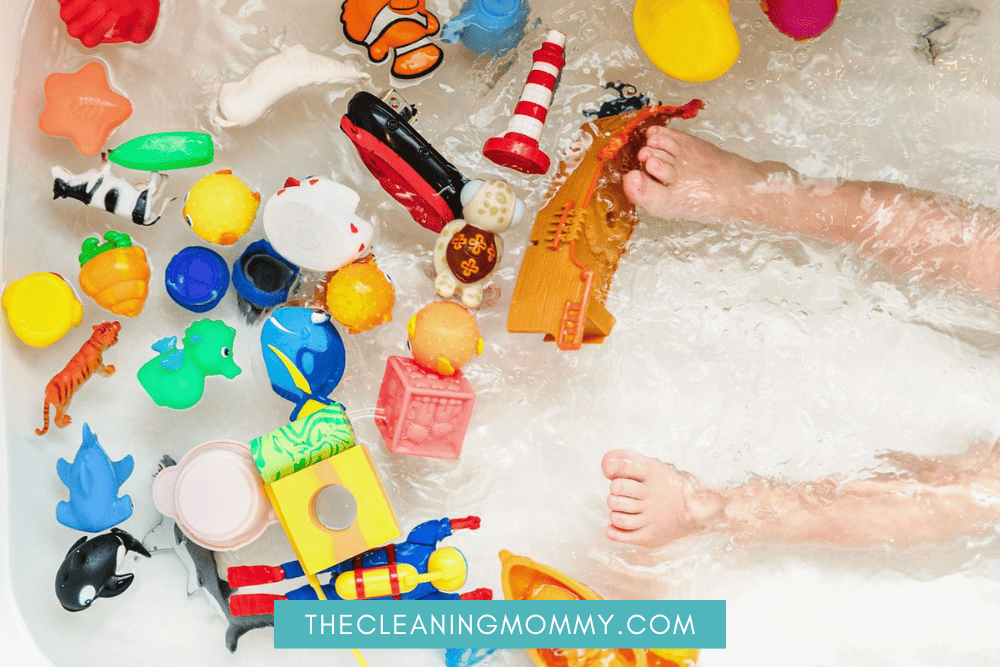
How to Clean Bath Toys Summary
In conclusion, keeping your child’s bath toys clean is crucial for their health and safety. Inside your child’ bath toys iis the perfect breeding ground for mold and unwanted organisms. By implementing proper cleaning methods, selecting easy-to-clean and mold-resistant toys, and practicing proper storage and toy rotation, you can ensure that bath time remains a fun and safe experience for your little one.
If it helps you to schedule a day where you can take care of this chore – do that! Maybe it’s a weekend day when your spouse is home and can help you with the kids, so you can take care of this chore.
If you don’t have much time, I find the dishwasher method is the best solution, because it doesn’t take much effort from you!
Frequently Asked Questions
What is the best way to clean kids bath toys?
To thoroughly clean and disinfect kids bath toys, use equal parts vinegar and water in a tub to submerge and soak the toys for at least 15 minutes. Additionally, you can bleach or boil the toys, or use hot water and dish soap for non-moldy toys. Lastly, rinse off with water for quick and easy cleaning.
How do you get mold and mildew out of bath toys?
To get rid of mold and mildew from bath toys, mix 1 tablespoon of bleach per gallon of water in a bucket. Submerge the toys in this solution for 10 minutes, then rinse them off really well and allow to air dry.
How do you bulk clean bath toys?
To bulk clean bath toys, add 1 gallon of water and 12 cup of bleach to a tub and submerge the toys. Soak them for 10 minutes, then remove from the bleach mixture and squeeze out the bleach water. Finally, rinse with tap water and air dry.
How often should you sanitize bath toys?
It is recommended to sanitize bath toys once a week, and also rinse and dry them thoroughly after each use. Doing so will help keep mold away and make them last longer.
How can I prevent mold growth on bath toys?
Regularly clean, store in a well-ventilated area or mesh bag, and rotate your bath toys to prevent mold growth. Standing water is never a good thing for wet items, so make sure those duckies are never left in a full tub of tap water.
Other Cleaning Articles You May Like:
- The Best Baby Safe Floor Cleaner (Safe For Pets Too)
- How To Clean Pack N Play Mattress (3 Ways)
- How To clean straps on high chair
- How to Wash Clothes With Poop On Them
- How To Wash Cloth Diapers For The First Time
- Things you should declutter in your home
- Get rid of mold on your clothes by doing this!
- Simple cleaning tasks you can do in 5 minutes
- Decluttering quotes you may like
- 3 Methods to clean a wicker basket
- How to wash onesies the best way

Grainne Foley
Grainne Foley is a wife and mother of 2 great kids. During her 5 years of full time RV travel, Grainne learned to become very efficient at household chores, in order to make time for family adventures. Now, back in a house, she has continued to create tools and techniques to help others lighten the load of household organization and cleaning.
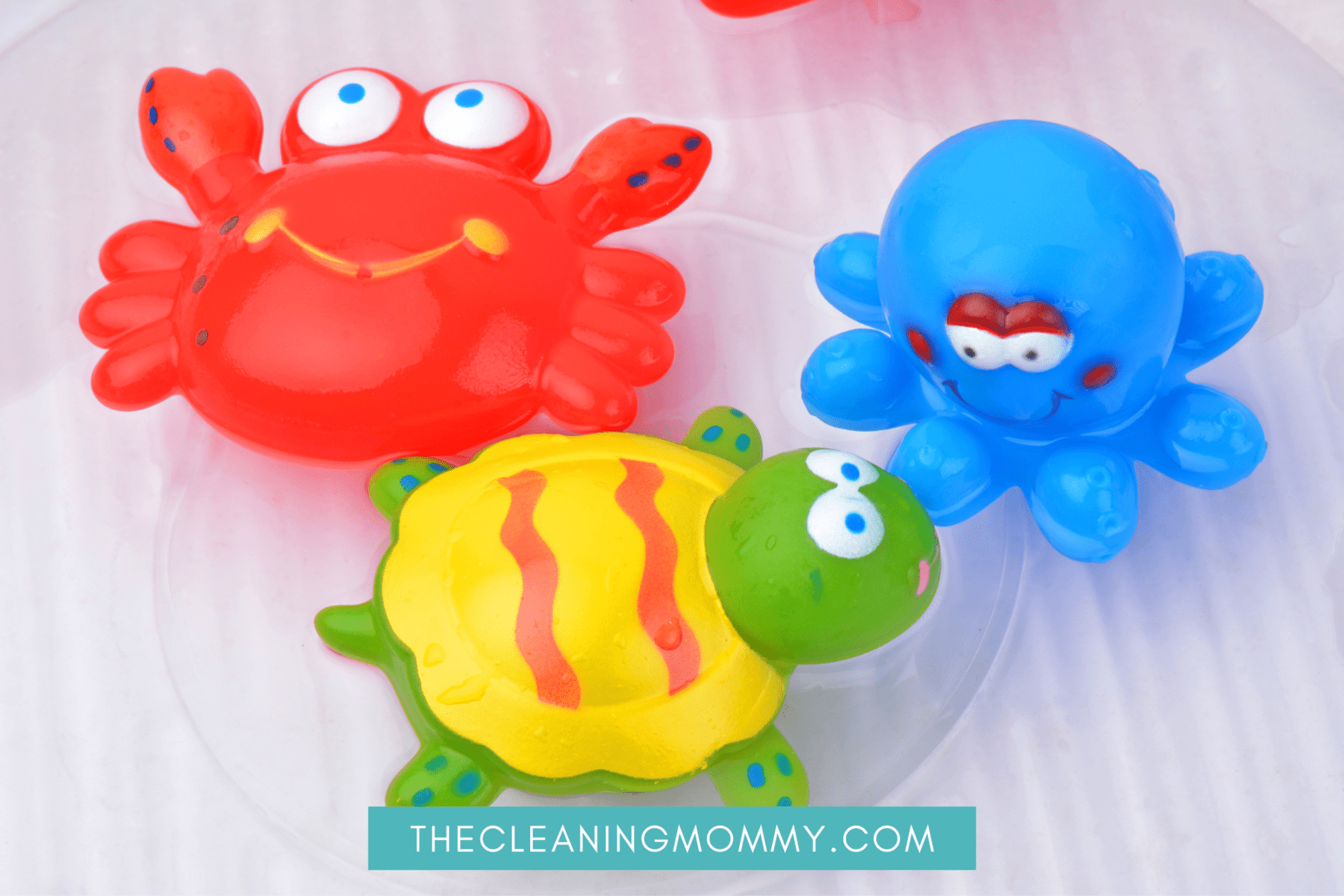
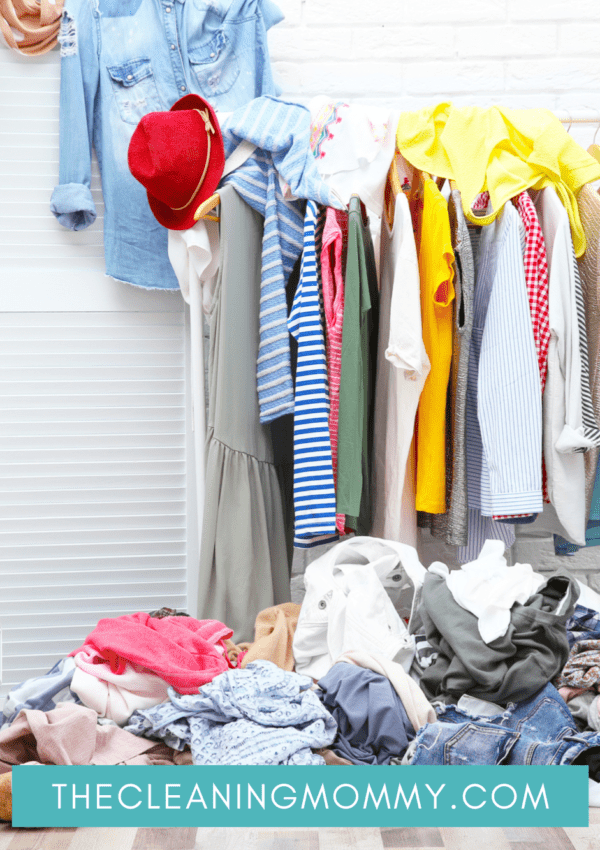

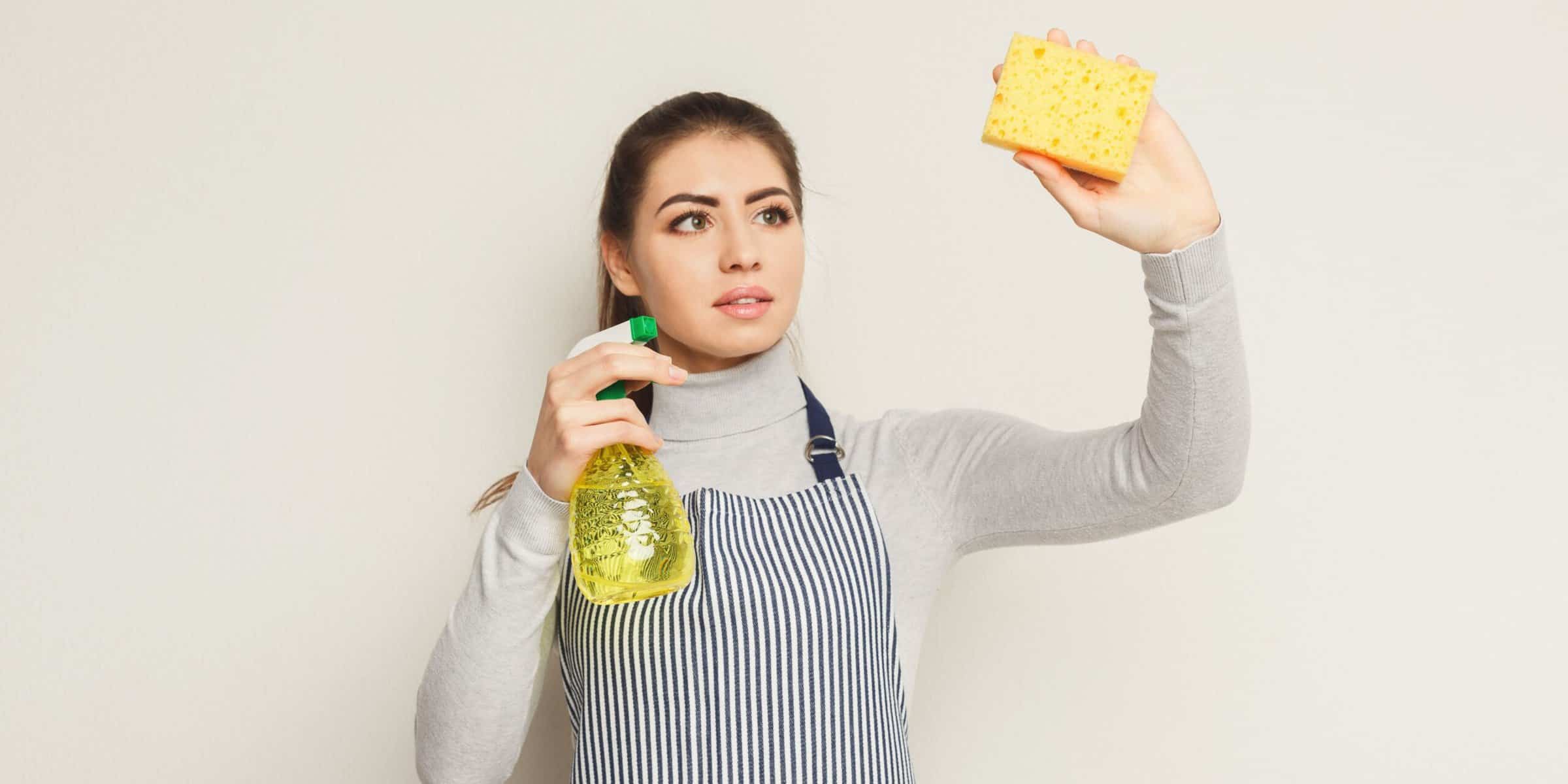
Leave a Reply